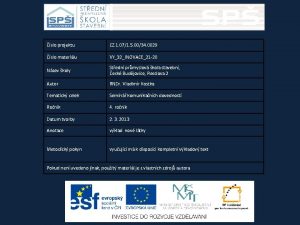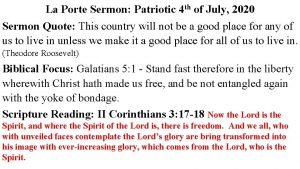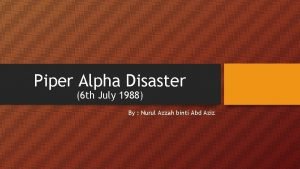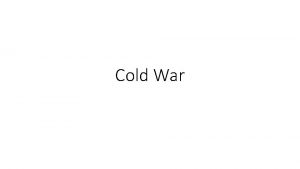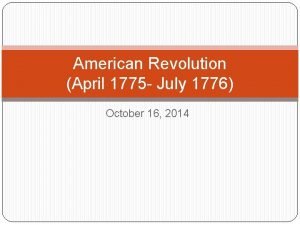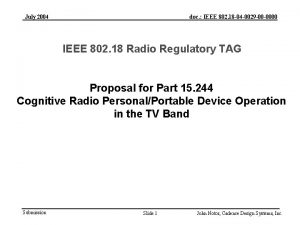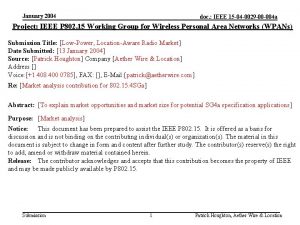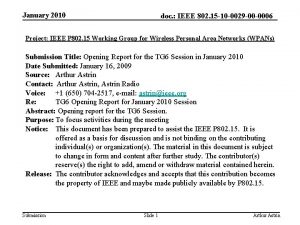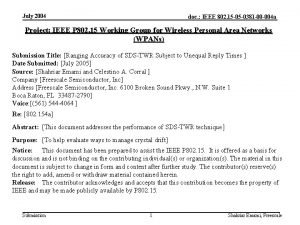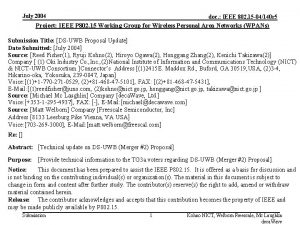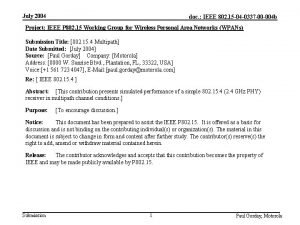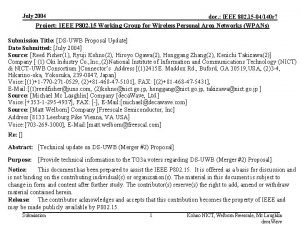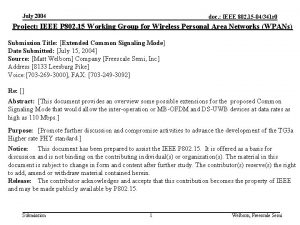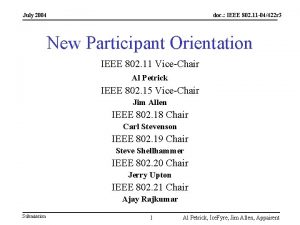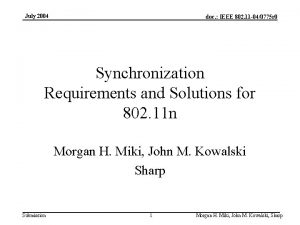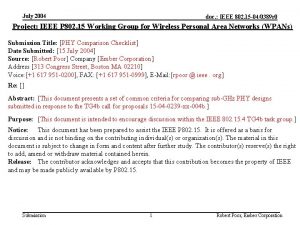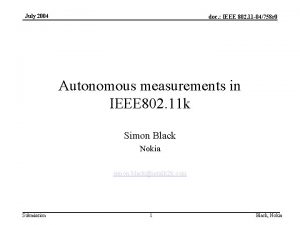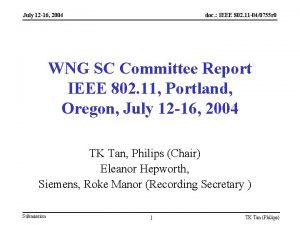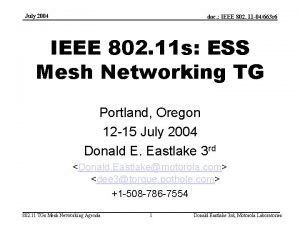July 2004 doc IEEE 802 18 04 0029































- Slides: 31

July 2004 doc. : IEEE 802. 18 -04 -0029 -00 -0000 IEEE 802. 18 Radio Regulatory TAG Proposal for Part 15. 244 Cognitive Radio Personal/Portable Device Operation in the TV Band Submission Slide 1 John Notor, Cadence Design Systems, Inc.

July 2004 doc. : IEEE 802. 18 -04 -xxxx-00 -0000 Outline • Introduction • TV Band Incumbents • Identifying Characteristics of Incumbents • Elements of Cognitive Radio Operation • Proposed Cognitive Radio Rules • Operating Range of Personal/Portable Devices • Detection of DTV Signals • DFS Sensitivity vs DTV Service Contour Field Strength • Co-Channel Interference Range Margin • Terrain Blocking • Wrap Up • Acknowledgements Submission 2 John Notor, Cadence Design Systems, Inc.

July 2004 doc. : IEEE 802. 18 -04 -xxxx-00 -0000 Introduction • On May 13, 2004, the FCC adopted ET Docket No. 04 -186, “Unlicensed Operation in the TV Broadcast Bands” in a Notice of Proposed Rulemaking (NPRM). • As written, ET-04 -186 proposes the following two classes of devices under a new rules section, Part 15. 244: • Personal/Portable Devices – 100 m. W peak transmitter power, 400 m. W peak EIRP (6 d. Bi antenna) –Transmission is permitted only when receiving a control signal indicating which TV channels are vacant from one of the following sources: a TV Broadcast station, an FM Broadcast station, or an unlicensed transmitter • Fixed Access Devices – 1 W peak transmitter power, 4 W peak EIRP (6 d. Bi antenna) –Must meet one of the following criteria –Include a GPS receiver and means of determining vacant TV channels in the area –Be installed by professionals to operate only on unused channels. Submission 3 John Notor, Cadence Design Systems, Inc.

July 2004 doc. : IEEE 802. 18 -04 -xxxx-00 -0000 Introduction • Although ET 04 -186 seeks comment on the possibility of using spectrum sensing, and other cognitive radio techniques, to identify and avoid TV channels occupied by an incumbent, and select channels for unlicensed operation, the Commission’s proposed rules sections do not permit that approach. • This presentation does the following: • Proposes a set of rules for an additional class of devices which permit cognitive radio technologies to be used in personal/portable unlicensed devices operating in the TV band under Part 15. 244. • Establishes that devices operating under these rules protect the operations of TV band incumbents based on widely available operational data and supporting analysis. Submission 4 John Notor, Cadence Design Systems, Inc.

July 2004 doc. : IEEE 802. 18 -04 -xxxx-00 -0000 TV Band Incumbents • Full Service TV Broadcast Stations (CFR 1 Title 47 Part 73). • Class A TV Broadcast Stations (CFR Title 47 Part 73 subpart J). • LPTV, TV Translator, TV Booster Stations, Auxiliary Operations, and Wireless Microphones (CFR Title 47 Part 74). • Private Land Mobile Radio Services (PLMRS) in 13 Metro Areas (CFR Title 47 Part 90), including Public Safety communications systems. • Commercial Land Mobile Radio Services (CMRS) in 13 Metro Areas (CFR Title 47 Part 20). • Wireless Medical Telemetry Services (WMTS) (CFR Title 47 Part 95 subpart H). Submission 5 John Notor, Cadence Design Systems, Inc.

July 2004 doc. : IEEE 802. 18 -04 -xxxx-00 -0000 TV Band Incumbent Protection from Cognitive Devices • In order to insure that public safety operations are protected, Ch 14 -20 are excluded from the proposed cognitive radio class of devices. • Wireless Medical Telemetry Services operate on Ch 37 within the TV band, which is excluded by the Commission’s proposed rules from Part 15. 244 device operations. • Wireless microphone operation as a Low Power Auxiliary Station under Part 74 can protected by cognitive techniques, or by rule (assignment to specific channels in each service area, etc). This presentation does not address wireless microphones. • Wireless video assist devices are provided for as Low Power Auxiliary Devices in Part 74, but no equipment is presently authorized or licensed for operation. This class of equipment should be considered for termination. • The remaining incumbents are TV broadcast signals, which, because of their unique signatures (analog/NTSC, and digital/ATSC), are readily identifiable. Submission 6 John Notor, Cadence Design Systems, Inc.

July 2004 doc. : IEEE 802. 18 -04 -xxxx-00 -0000 Analog TV (NTSC) Spectrum • Power primarily confined to Video and Audio carriers. • Distinctive double peaked spectrum makes identification by spectrum profiling relatively easy. • Relatively high narrowband power levels compared to DTV. Submission 7 John Notor, Cadence Design Systems, Inc.

July 2004 doc. : IEEE 802. 18 -04 -xxxx-00 -0000 Digital TV (ATSC) Spectrum • Power spread over center 5. 38 MHz within a TV channnel. • Pilot tone is a distinctive feature when observed in a narrowband receiver. • Pilot tone power is 11. 3 d. B below average power measured in a 6 MHz bandwidth. Submission 8 John Notor, Cadence Design Systems, Inc.

July 2004 doc. : IEEE 802. 18 -04 -xxxx-00 -0000 Elements of Cognitive Radio Operation (1) 1. Network Frequency Allocation (NFA): – Survey and monitor spectrum use patterns. – Avoid incumbents, operate network on an unused or lightly used channel. 2. Link Power Control (LPC): – Keep network transmitter power low while maintaining good link quality. – LPC mitigates interference and promotes frequency reuse with networks located nearby. 3. Incumbent Profile Detection (IPD): – Detect incumbent users based on specific spectrum signature (supports NFA) – Example: detecting the presence of a sound/video carriers in NTSC (analog TV) systems or a pilot tone in ATSC (DTV) systems. 4. Collision Detection And Avoidance (CDAA): – Transmitters wait until the channel is quiet before transmitting (“listen before talk”). – A receiving node acknowledges valid data by transmitting a response. – A transmitting node “detects” a collision if it does not receive an acknowledgement before a timeout occurs. – The protocol implements an appropriate backoff/retry timing mechanism for retransmission when a collision is detected. 1. Notor, J. , Radio Architectures for Unlicensed Reuse of Broadcast TV Channels, Communications Design Conference 2003. Submission 9 John Notor, Cadence Design Systems, Inc.

July 2004 doc. : IEEE 802. 18 -04 -xxxx-00 -0000 Proposed Cognitive Radio Rules • These rules extend the FCC’s proposed rules for personal/portable devices to authorize cognitive radio techniques. • Dynamic Frequency Selection (DFS) threshold: a TV channel shall be considered unoccupied when the electric field strength at the receiving antenna is less than the following averaged for 10 ms over the entire 6 MHz channel. – For Ch 5 -6, E(d. Bu) < -7 d. Bu. V/m/10 k. Hz – For Ch 7 -13, E(d. Bu) < 1 d. Bu. V/m/10 k. Hz – For Ch 21 -51, excluding Ch 37 E(d. Bu) < 11 d. Bu. V/m/10 k. Hz • To operate on a channel whose ambient field strength is greater than the DFS threshold, the cognitive device must, using appropriate Incumbent Profile Detection techniques, verify that the channel is not being occupied by either an analog or a digital TV signal. • The cognitive radio network shall give priority to operation on empty or lightly occupied channels. Submission 10 John Notor, Cadence Design Systems, Inc.

July 2004 doc. : IEEE 802. 18 -04 -xxxx-00 -0000 Proposed Cognitive Radio Rules • Transmit Power Control (TPC) – Link Power Control protocols must be included in the cognitive radio devices to minimize transmitter power while supporting reliable communications between any transmitter and any single receiver. – The LPC protocol operation shall cause the transmitter in any single node to single node link to begin reducing output power when the signal level at the receiver is greater than 20 d. B above the receiver’s nominal sensitivity. – The TPC function shall keep the signal level at the receiver less than 30 d. B above the receiver’s nominal sensitivity at least 50% of the time, including the impact of any regular broadcast operations (transmission from a controlling node to all other nodes). • Listen Before Talk – The transmitters must operate in burst mode, with a maximum continuous burst length less than 1 second. – Cognitive radio devices must monitor the operational channel periodically to verify that the channel remains unoccupied by an analog or digital TV signal. Submission 11 John Notor, Cadence Design Systems, Inc.

July 2004 doc. : IEEE 802. 18 -04 -xxxx-00 -0000 Operating Range of Personal/Portable Devices Table 1: Range data based on customer survey information (2) 2. Table provided by Southern Communications and Electronics at the following web site: http: //www. southernce. com/cgi-bin/Soft. Cart. exe/range. htm? L+scstore+josy 3749+1088643303 Submission 12 John Notor, Cadence Design Systems, Inc.

July 2004 doc. : IEEE 802. 18 -04 -xxxx-00 -0000 Operating Range of Personal/Portable Devices • VHF Loss Exponent estimates based on the operational characteristics of MURS radio handsets (151. 820 MHz < fc < 154. 600 MHz). – Sensitivity: 0. 2 u. V at limit of range, or -121 d. Bm – Antenna Gain: 0 d. Bi – Tx Power: 2 W (+33 d. Bm) – Loss to limit of sensitivity: 33 – (-121) = 154 d. B. – Loss Exponent (LE) = 154/[10*log(d)], where d is the range in m. • Table 2: Anecdotal range data based on Table 1 with loss exponent: Est. Range (m) LE Conditions 6436 4. 0 Outdoors, clear flat terrain 3620 4. 3 Suburban outdoor environments 2011 4. 7 Urban outdoor environments 805 5. 3 Inside shopping mall Submission 13 John Notor, Cadence Design Systems, Inc.

July 2004 doc. : IEEE 802. 18 -04 -xxxx-00 -0000 Operating Range of Personal/Portable Devices • UHF Loss Exponent estimates based on the operational characteristics of FRS radio handsets (462. 5625 MHz < fc < 467. 7125 MHz). – Sensitivity: 0. 2 u. V at limit of range, or -121 d. Bm – Antenna Gain: 0 d. Bi – Tx Power: 500 m. W (+27 d. Bm) – Loss to limit of sensitivity: 27 – (-121) = 148 d. B. – Loss Exponent (LE) = 148/[10*log(d)], where d is the range in m. • Table 3: Anecdotal range data from various sources with loss exponent: Data Source Est. Range (m) LE Conditions Manufacturers 3218 4. 2 Over water Mc. Guinn 2413 4. 4 Hotel to hotel, 15 th story room to lobby, Disney World Various 1609 4. 6 Normal cluttered outdoor environment Notor 984 4. 9 Outdoors in Willow Glen Neighborhood, San Jose, CA Other 402 5. 7 Inside shopping mall Submission 14 John Notor, Cadence Design Systems, Inc.

July 2004 doc. : IEEE 802. 18 -04 -xxxx-00 -0000 Operating Range of Personal/Portable Devices • VHF/UHF Loss Exponent (LE) range: 4 -5. 7 • Loss exponents by environment: – Clear flat terrain: LE = 4 – Outdoor suburban/urban environment: LE = 4. 3 - 4. 9 – Indoor to indoor, 15 th floor hotel room to hotel lobby: LE = 4. 4 – Inside shopping mall: 5. 3 -5. 7 • Operational experience based on loss exponent analysis tracks well between VHF and UHF portable radios. Submission 15 John Notor, Cadence Design Systems, Inc.

July 2004 doc. : IEEE 802. 18 -04 -xxxx-00 -0000 Detection of DTV Signals • DTV is the limiting case re: DFS/IPD for TV signals. • Receiver Assumptions: – CNR: 6 d. B is sufficient for detection of a narrowband signal like an ATSC pilot tone. – NF: 5 d. B – Antenna Gain: 0 d. Bi – Predetection Bandwidth: 10 k. Hz – Post Detection Time Constant: 10 ms – Square Law Detector • Sensitivity Calculation (CNR = 6 d. B) S = -174 d. Bm/Hz + 10 log(10 k. Hz) + 5 d. B + 6 d. B S = -123 d. Bm Submission 16 John Notor, Cadence Design Systems, Inc.

July 2004 doc. : IEEE 802. 18 -04 -xxxx-00 -0000 Detection of DTV Signals • For a DFS detection threshold of -123 d. Bm/10 k. Hz applied to identifying a DTV signal by detecting the pilot tone, the equivalent clear channel DFS threshold for a DTV signal becomes: – DTV DFS = -123 d. Bm + 11. 3 d. B = -111. 7 d. Bm ~ -112 d. Bm in a 6 MHz bandwidth – -112 d. Bm is below thermal noise floor for a 6 MHz bandwidth, i. e. Np = -174 d. Bm + 10 log(6 MHz) = -106. 2 d. Bm > -112 d. Bm, but the analysis remains valid, since the pilot tone can be detected in a 10 k. Hz bandwidth. • Assuming a 0 d. Bi antenna and a 50 Ohm reference impedance, the equivalent DFS threshold in terms of electric field strength in a 6 MHz bandwidth is – E(d. Bu) = P(d. Bm) + 20 log[f(MHz)] + 77. 2 – For Ch 6, E(d. Bu) = -112 + 20 log[85] + 77. 2 = 4 d. Bu. V/m – For Ch 13, E(d. Bu) = 12 d. Bu. V/m – For Ch 51, E(d. Bu) = 22 d. Bu. V/m Submission 17 John Notor, Cadence Design Systems, Inc.

July 2004 doc. : IEEE 802. 18 -04 -xxxx-00 -0000 DFS Sensitivity vs DTV Service Contour Field Strength • The sensitivity margin relative to the minimum in-service DTV field strength for a 30 ft high receive antenna is: – For Ch 6, margin = 28 – 4 = 24 d. B – For Ch 13, margin = 36 – 12 = 24 d. B – For Ch 51, margin = 41 – 22 = 19 d. B • For a receiver outdoor antenna height of 2 m (nomadic personal/portable device), reduce the sensitivity margin by a 9 d. B correction factor (3). • Table 4 (p. 19) shows sensitivity margin calculations for various stations in the FCC database, using the FCC calculator at: http: //www. fcc. gov/mb/audio/bickel/curves. html. • The DFS detector operating outdoors with an antenna height of 2 m can sense a TV channel outdoors at ranges > 21% farther than the service contour (Table 4) in unobstructed terrain. 3. Mehrotra, A. , Cellular Radio Performance Engineering, Artech House, 1994, p 146 Submission 18 John Notor, Cadence Design Systems, Inc.

July 2004 doc. : IEEE 802. 18 -04 -xxxx-00 -0000 Table 4: DFS Sensitivity Margin Service Area Contour DFS (4) DFS Range DTV Band HAAT ERP Limit Range Margin Ch (MHz) (m) (k. W) (d. Bu) (km) (%) WCFT-TV, Tuscaloosa, AL 5 76 -82 625. 4 9. 5 28 128. 7 12 182. 4 53. 7 41. 7% KNSO, Merced, CA 5 76 -82 575. 0 11. 0 28 126. 5 12 181. 7 55. 2 43. 6% KYES, Anchorage, AK 6 82 -88 277. 0 45. 0 28 120. 5 13 180. 5 60. 0 49. 8% WEDY, New Haven, CT 6 82 -88 88. 0 0. 4 28 56. 0 13 83. 9 27. 9 49. 8% KMBC-TV, Kansas City, MO 7 174 -180 357. 0 85. 0 36 114. 7 19 173. 6 58. 9 51. 4% KNTV, San Jose, CA 12 204 -210 376. 6 103. 1 36 118. 2 20 174. 7 56. 5 47. 8% WDAF-TV, Kansas City, MO 34 590 -596 295. 0 1000. 0 41 96. 2 30 125. 1 28. 9 30. 0% KLCS, Los Angeles, CA 41 626 -632 900. 8 162. 0 41 115. 5 30 140. 5 25. 0 21. 6% WMSY-TV, Marion, VA 42 638 -644 448. 0 100. 0 41 89. 8 30 112. 9 23. 1 25. 7% KWDK, Tacoma, WA 42 638 -644 695. 0 144. 0 41 107. 0 31 129. 7 22. 7 21. 2% WTVX, Fort Pierce, FL 50 686 -692 438. 3 704. 0 41 106. 0 31 132. 2 26. 2 24. 7% KOPX, Oklahoma City, OK 50 686 -692 483. 0 200. 0 41 97. 8 31 120. 1 22. 3 22. 8% KDTV, San Francisco, CA 51 692. 698 701. 0 476. 3 41 118. 5 31 144. 1 25. 6 21. 6% Station, Locale 4. The DFS limit is calculated at a 2 m antenna height, assuming a 9 d. B loss relative to signal strength at 30 ft (~9 m). So, for Ch 6, DFS Limit =4 d. Bu. V/m + 9 d. B =13 d. Bu. These calculations exclude terrain blockage effects. Submission 19 John Notor, Cadence Design Systems, Inc.

July 2004 doc. : IEEE 802. 18 -04 -xxxx-00 -0000 Co-Channel Interference Range Margin • Part 15. 244 Device Tx Operating Parameters: – EIRP: 400 m. W, or +26 d. Bm – E(d. Bu) = 104. 8 + EIRP(d. Bm) – 20*log(D) = 131 d. Bu at D = 1 m. – Loss exponent (LE): 4 (lower limit of operational experience for portable devices). • DTV Co-channel D/U: 23 d. B at the edge of the service area. • Maximum allowed co-channel interference field strength at the edge of the service contour (Full service DTV) – Ch 5 -6: 28 – 23 = 5 d. Bu – Ch 7 -13: 36 – 23 = 13 d. Bu – Ch 14 -51: 41 – 23 = 18 d. Bu • Interference Range (R), LE = 4, to DTV co-channel D/U = 23 d. B limit – Ch 5 -6: R = 10[(131 – 5) / 40] = 1. 4 km – Ch 7 -13: R = 891 m – Ch 14 -51: R = 668 m Submission 20 John Notor, Cadence Design Systems, Inc.

July 2004 doc. : IEEE 802. 18 -04 -xxxx-00 -0000 Co-Channel Interference Range Margin • FCC propagation calculations indicate that a unlicensed spectrum sensing device operating outdoors can sense a DTV signal 22 -60 km outside the service contour of a DTV station, excluding terrain blocking effects. • The range of a Part 15. 244 personal/portable device transmitter operating at a +26 d. Bm EIRP to the field strength limit for an undesired co-channel signal within a service contour is 668 m to 1. 4 km. • So, DTV services areas are protected by a buffer zone (excluding terrain blockage effects) of greater than 20 km using spectrum sensing techniques. Submission 21 John Notor, Cadence Design Systems, Inc.

July 2004 doc. : IEEE 802. 18 -04 -xxxx-00 -0000 Co-Channel Interference Range Margin Limit of DFS Sensing Capability DTV Service Area 22 -60 km Edge of Service Contour Cognitive Radio Range to 23 d. B D/U Limit R <1. 4 km (+26 d. Bm EIRP, LE = 4) Submission 22 John Notor, Cadence Design Systems, Inc.

July 2004 doc. : IEEE 802. 18 -04 -xxxx-00 -0000 Terrain Blocking • Reduces the available signal level significantly in the blocked area relative to adjacent unblocked areas due to terrain features: mountains, buildings, interior walls. Example terrain blocking losses: – 40 d. B over an 8 km stretch in Virginia for 50% of the cases, much fewer instances of 40 d. B change for smaller geographic segments (5) – 37 d. B over a ~ 4 km stretch in Boulder, CO (6) (see p 24) – 27 d. B over an ~ 2. 4 km stretch (7) in Boulder, CO (see p. 25) – 10 d. B for building shadowing losses, and 10 -20 d. B for building penetration losses (8, 9) (see p 26). Note: For the data in Table 5, the indoor antenna was placed next to a window on the same side of the building where the outdoor signal strength was measured, which tends to produce more optimistic results than otherwise. • Reduces the range margin at the edge of a service contour over that available in an unblocked situation. 5. Mc. Henry & Byrnes, Shared Spectrum Company Comments to FCC ET-02 -380, p 9 6. Holoway, Sanders, & Mc. Kenna, NTIA Report 01 -387, p 24 and Figure 14 7. Holoway, Sanders, & Mc. Kenna, NTIA Report 01 -387, p 24 and Figure 16 8. Mc. Henry & Byrnes, Shared Spectrum Company Comments to FCC ET-02 -380, p. 6 8. Salehian, Khalil, Comparison Between the Field Strength of DTV Signals Inside and Outside of the Buildings, Communications Research Centre Canada. Submission 23 John Notor, Cadence Design Systems, Inc.

July 2004 doc. : IEEE 802. 18 -04 -xxxx-00 -0000 Geographic Terrain Blocking ~ 4 km 1. 3 V/m 37 d. B 0. 018 V/m Figure 14 reproduced from Holoway, Sanders, & Mc. Kenna, NTIA Report 01 -387 Submission 24 John Notor, Cadence Design Systems, Inc.

July 2004 doc. : IEEE 802. 18 -04 -xxxx-00 -0000 Geographic Terrain Blocking ~ 2. 4 km 1. 2 V/m 27 d. B 0. 055 V/m Figure 16 reproduced from Holoway, Sanders, & Mc. Kenna, NTIA Report 01 -387 Submission 25 John Notor, Cadence Design Systems, Inc.

July 2004 doc. : IEEE 802. 18 -04 -xxxx-00 -0000 Terrain Blocking By Buildings Table 5: Outdoor to Indoor Propagation Data (10) Site Number Outdoor 10 meters Outdoor 2 meters Indoor Floor # Outdoor 10 m Outdoor 2 m (d. B) Outdoor 10 m - Indoor (d. B) 2 -54. 6 -72 -62. 2 2 17. 4 7. 60 3 -71 -77 -70 2 6 -1. 00 4 -35. 3 -47. 2 -51 1 11. 9 15. 70 -34. 6 2 -60. 4 1 -58. 1 2 5 -47 -67 -0. 70 20 13. 40 11. 10 6 -37. 7 -53. 2 -46. 1 2 15. 5 8. 40 7 -69. 2 -74. 3 -67 2 5. 1 -2. 20 8 -44. 9 -63. 1 -61. 9 1 18. 2 17. 00 -54. 2 2 -58. 9 4 10. 3 8. 70 Average 13. 44 7. 94 Notes: Min 5. 10 -2. 20 1. Sites 1 -8 are 1 -2 story suburban brick homes. Max 20. 00 17. 00 2. Site 9 is a tall concrete apartment building. Std Dev 5. 63 6. 65 9 -50. 2 -60. 5 9. 30 (10) Ibid, adapted from the original CRC Canada report, including the addition of the last two columns of analysis. Submission 26 John Notor, Cadence Design Systems, Inc.

July 2004 doc. : IEEE 802. 18 -04 -xxxx-00 -0000 Terrain Blocking Mitigation • Limit transmit power of devices. – At +26 d. Bm EIRP, the range of personal/portable devices to the co-channel D/U threshold is < 1. 4 km on Ch 5 -6, < 900 m on higher frequency channels, i. e. , less than the expected shadow footprint (see p. 28). – Using TPC reduces the interference range by reducing network aggregate transmitter power. – Burst mode operation reduces the impact of transmissions to DTV operation relative to the assumption of continuous operation built into the D/U regulatory limits. • Require all devices to include DFS/IPD capability, not just access points – If all devices include DFS/IPD capability, the spectrum sensing footprint is increased, reducing the probability that an occupied channel will go undetected. – Avoids the possibility of a shadowed master control device accidentally trying to set up the network co-channel with a TV broadcast incumbent. Submission 27 John Notor, Cadence Design Systems, Inc.

July 2004 doc. : IEEE 802. 18 -04 -xxxx-00 -0000 Co-Channel Interference in Blocked Terrain DTV Service Area Terrain Shadow Lb Cognitive Radio Range to 23 d. B D/U 668 m < R <1. 4 km at +26 d. Bm EIRP Edge of Service Contour Submission Shadow Depth (d. B) Lb (km) 27 37 40 2. 4 4. 0 8. 0 28 John Notor, Cadence Design Systems, Inc.

July 2004 doc. : IEEE 802. 18 -04 -xxxx-00 -0000 Wrap Up • Based on the proposed rules for personal/portable devices, the operational data, and the analysis presented herein, cognitive devices using spectrum sensing techniques can reliably operate in the TV band without causing interference to TV broadcast channels. • The cognitive radio mode of operation for personal/portable devices is proposed as an addition to the rules for Part 15. 244 devices already suggested by the FCC in the TV Band NPRM. • The application of cognitive radio technology to TV band unlicensed operation is an important step in realizing the full potential for a wide range of centralized and distributed networks utilizing otherwise unoccupied spectrum. Submission 29 John Notor, Cadence Design Systems, Inc.

July 2004 doc. : IEEE 802. 18 -04 -xxxx-00 -0000 Acknowledgements • The following organizations and individuals were immensely helpful in preparing this presentation: – The Berkeley Wireless Research Center, especially – Professor Robert W. Brodersen – Gary Kelson – Danielja Cabric’ – The Communications Research Centre Canada, especially – Gerald Chouinard – David Rogers – Khalil Salehian – Intel Corporation, especially – Jeffrey Schiffer – Alan E. Waltho Submission 30 John Notor, Cadence Design Systems, Inc.

July 2004 doc. : IEEE 802. 18 -04 -xxxx-00 -0000 Acknowledgements – Shared Spectrum Corporation, especially – Mark Mc. Henry – William Byrnes – Professor Adam Wolisz, Technische Universitat Berlin – Michael Lynch, Nortel – Denis Kuwahara, Boeing Submission 31 John Notor, Cadence Design Systems, Inc.
 071-com-0029
071-com-0029 Bridges from 802.x to 802.y
Bridges from 802.x to 802.y Bridges from 802.x to 802.y
Bridges from 802.x to 802.y Ieee 802 family
Ieee 802 family Ieee 802 3 compliance
Ieee 802 3 compliance Ieee802.22
Ieee802.22 Arquitetura ieee 802
Arquitetura ieee 802 Estandares ieee 802
Estandares ieee 802 Ieee 802 standard
Ieee 802 standard Ieee 802 bluetooth
Ieee 802 bluetooth 802 ieee
802 ieee Ieee 802
Ieee 802 Why are leaf yeasts more plentiful in july
Why are leaf yeasts more plentiful in july Uninvited guests harris burdick
Uninvited guests harris burdick June 22 to july 22
June 22 to july 22 Imagery in poppies in july
Imagery in poppies in july 2001 july 15
2001 july 15 January february march april may june july august
January february march april may june july august July 4 sermon
July 4 sermon 6th july 1988
6th july 1988 May 1775
May 1775 July 26 1953
July 26 1953 Oscar and alphonse harris burdick
Oscar and alphonse harris burdick July 12 1776
July 12 1776 July 10 1856
July 10 1856 2003 july 17
2003 july 17 July 14 1789
July 14 1789 Monday 13th july
Monday 13th july June too soon july stand by
June too soon july stand by I am silver and exact i have no preconceptions
I am silver and exact i have no preconceptions Gcc july 2020
Gcc july 2020 July 16 1776
July 16 1776
